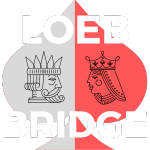In a competitive auction with support for your partner’s suit, you want to show support and your strength. If you are weak and have length in your partner’s suit, you would like to preempt the auction to make it difficult for your opponents to find their right strain and level.
|
North |
East |
South |
West |
|
1♠ |
2♥ |
? |
|
On the above auction, South, with spade support would like a way to show:
-
A game forcing raise
-
An invitational raise
-
A constructive raise (7-10 Support Points)
-
A weak raise, preempting the opponents, leaving them with little bidding room
When the opponents bid a suit, you rarely want to play in their suit. It isn’t wise to use a bid of the opponent’s suit (called a Cue Bid) to show length in the opponent’s suit. It is better to use a Cue Bid to show support for your partner’s suit. Since a Cue Bid (a bid of the opponent’s suit) is forcing, you can use it to show both invitational raises and game forcing raise (explained as an invitational or better raise).
|
Responder’s Bid |
Meaning |
Example |
|
2♠ |
Constructive raise, 7-10 Support Points |
♠A92 ♥74 ♦K872 ♣J753 |
|
3♥ |
Invitational or better raise |
♠A92 ♥74 ♦K872 ♣A753 |
|
3♠ |
Weak raise, typically 4 spades |
♠K982 ♥74 ♦J8742 ♣53 |
|
4♥ |
Game forcing Splinter Bid |
♠AT92 ♥7 ♦K872 ♣K753 |
|
4♠ |
Weak raise, typically 5 spades |
♠Q9842 ♥4 ♦8742 ♣953 |
Cue bids to show an invitational or better raise can also be used after your partner’s overcall. The logic is similar after a 2-level overcall which shows 12-17 HCP and a 5+ card suit. Since a 1-level overcall has an 8-17 HCP hand, you cannot assume a game is available if you have support and 13 HCP. You make a second game try to show an opening hand with support if your first invitation is declined.
|
North |
East |
South |
West |
|
1♣ |
1♥ |
1♠ |
? |
On the auction above, West with heart support, will want to show their strength and their support. You want use 2♣ and 3♣ to show support. South showed 4+ spades. Since it is possible for East-West to have an 8+ card spade fit, it is best to treat a 2♠ bid as natural, showing 5+ spades, and forcing. Use a 2♣ Cue Bid to show an invitational or better raise. This leaves a jump Cue Bid (a jump to 3♣) to differentiate between a very good constructive raise from other constructive raises. A very good constructive raise is called a Mixed Raise because it is in between a normal constructive raise and an invitational raise. A jump Cue Bid (3♣ on the above auction) shows 4+ card support for partner’s suit, and 7-10 Support Points. It always has a doubleton or shorter side suit. It denies a 4-3-3-3 distribution. A Mixed Raise is valuable because it helps partner when they have a close decision on whether to bid a game.
Here is a summary of West’s options supporting East’s 1♥ overcall.
|
Advancer’s Bid |
Meaning |
Example |
|
2♥ |
Constructive raise, 6-10 Support Points |
♠Q92 ♥K74 ♦K8 ♣J8753 |
|
2♣ |
Invitational or better raise |
♠74 ♥A92 ♦K872 ♣A753 |
|
3♣ |
Mixed Raise |
♠A8 ♥Q982 ♦8742 ♣Q53 |
|
3♥ |
Weak raise, typically 4 hearts |
♠74 ♥K982 ♦J8742 ♣53 |
|
4♣ |
Game forcing Splinter Bid |
♠A92 ♥K982 ♦KT872 ♣3 |
|
4♥ |
Weak raise, typically 5 hearts |
♠4 ♥Q9842 ♦8742 ♣953 |
In a competitive auction, use a cue bid to differentiate a competitive raise from an invitational raise.
|
North |
East |
South |
West |
|
1♣ |
1♥ |
2♠ (weak) |
? |
|
Advancer’s Bid |
Meaning |
Example |
|
3♣ |
Invitational or better raise |
♠74 ♥A92 ♦K872 ♣A753 |
|
3♥ |
Competitive raise |
♠A2 ♥K874 ♦873 ♣J753 |
|
4♥ |
Preemptive raise |
♠6 ♥K8742 ♦J854 ♣974 |
Suggest advanced partnerships use 3♠ and 4♣ as Splinter Bid slam tries.




